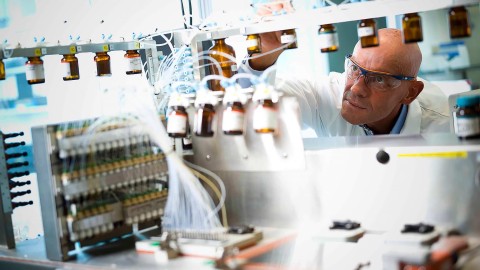Risk assessment: Laboratory processes
In every laboratory, employees handle chemical substances or biological agents on a daily basis and are therefore exposed to particular health risks - such as the inhalation of toxic vapors, burns, skin and eye irritation or even explosions. To avoid such problems, work may only be carried out in a laboratory after all potential hazards have been assessed and all necessary protective measures have been implemented.
According to the Occupational Health and Safety Act, as an employer you are obliged to carry out a risk assessment for your laboratories, among other things. Your employer's liability insurance association or Infraserv Höchst's occupational safety and laboratory operations specialists can tell you how to conduct a risk assessment for laboratory operations and what aspects need to be considered. For example, you can refer to the catalog of hazards published by the German Social Accident Insurance Institution for the raw materials and chemical industry (BG RCI). The current versions of DGUV information 213-850 “Safe working in laboratories” and 213-086 “Biological laboratories” from the German Social Accident Insurance provide further information.
Risk assessment of laboratory processes
1. Define areas of responsibility and activities
For the risk assessment, it is first necessary to record the company organization of the company concerned in areas such as occupational safety, emergency measures and first aid and then to define clear areas of activity for the risk assessment. Similar areas of activity, such as office workplaces, can be considered collectively in the risk assessment. If new areas of activity are added - for example a new extension - these must be reassessed.
The Occupational Health and Safety Act (ArbSchG) is always the starting point for defining the areas of activity. If necessary, other legislation such as the Ordinance on Hazardous Substances (GefStoffV), the Ordinance on Biological Substances (BioStoffV) or the Maternity Protection Act (MuSchG) with its provisions for pregnant women in the workplace are consulted as additional bases.
As the responsible employer, you have the option of seeking advice or assistance from proven experts – such as an experienced external laboratory service provider like Infraserv Höchst - to conduct the risk assessment.
Laboratory employees are also required to participate in the risk assessment because they have direct knowledge of the hazards in their work environment. For this reason, discussions with employees about their working conditions and laboratory inspections are conducted in advance of the risk assessments.
If necessary, other specialists such as occupational safety experts, company physicians, the works council or safety officers should be consulted. Infraserv Höchst calls in specialized departments as needed to competently assess the risks posed by hazardous and biological substances.
It is important to clearly assign responsibilities and tasks to everyone involved. As an employer, you can delegate the risk assessment to other competent, authorized persons, such as a qualified laboratory or technical manager - or to an experienced external laboratory service provider like Infraserv Höchst. However, the employer always retains overall
2. Identify hazards and evaluate risks
A laboratory risk assessment must be performed at all laboratory workstations and for every laboratory activity - even before laboratory operations begin.
As a service provider, Infraserv Höchst can prepare a risk assessment for your work areas. We use checklists based on the criteria of the German Social Accident Insurance Institution for the raw materials and chemical industry (BGR CI). The BGR CI lists a total of 17 hazard areas and suggests suitable measures for these. In practice, these must be adapted to the requirements of the respective company.
Typical hazards in the laboratory include
- Structural defects such as inadequate fire protection, poor ventilation or inadequate escape and rescue routes,
- Risk of fire and explosion due to hazardous substances,
- Health hazards due to solid, liquid or gaseous substances,
- Radiation and electromagnetic fields,
- Eye and skin irritation or chemical burns,
- Unfavorable room climate without sufficient ventilation,
- Unsuitable workplace lighting and other aspects of ergonomics,
- Unexpected chemical reactions, e.g. due to interactions between hazardous substances,
- Hazards from containers with negative and positive pressure, hot and cold media,
- Mechanical hazards from machines and systems,
- Noise pollution at the workplace,
- Strain on the musculoskeletal system due to unfavorable working postures and monotonous activities,
- Mental stress factors,
- New forms of work such as working from home,
- Missing or inadequate operating instructions for hazardous substances and machinery,
- Missing or inadequate emergency equipment such as personal protective equipment or eye showers.
3. Identification of suitable protective measures
The risk assessment, taking into account § 4 of the Hazardous Substances Ordinance (GefStoffV) and § 7 of the Biological Substances Ordinance (BioStoffV), forms the basis for measures to ensure safe working in the laboratory. Potential hazards must be reassessed whenever work processes, workstation equipment or conversions are changed:
- Recording the company organization within the company structure,
- Recording all laboratory activities,
- Determining potential hazards and stresses, for example by exceeding limit values for hazardous substances and noise exposure.
Employee surveys and site inspections play an important role in identifying hazards and stress factors in the laboratory. In addition, existing documents such as operating instructions, hazardous substance lists, job descriptions, test reports or measurement logs can be used.
The creation of a risk matrix with prioritization of risks according to potential damage severity and frequency helps to prioritize the protective measures.
Infraserv's specialist departments take a closer look at specialized areas such as the handling of biological substances. A dedicated measurement team is also available for hazardous substance measurements.
4. Implement measures
The risk matrix is then used to assess the risk based on the findings and define specific occupational safety measures to eliminate hazards for lab employees as far as possible. Based on the gap between the actual and target status, the necessary measures are identified and a corresponding timetable for implementation is defined. The focus here includes
- The substitution of hazardous substances with less or non-hazardous substances,
- Technical protective measures relating to laboratory construction (escape, rescue and transport routes, doors, floors, ventilation systems and extraction devices) as well as workplace design with operating and circulation areas or work tables,
- Organizational protective measures such as reducing the time spent in noise zones,
- Personal protective equipment,
- Precautionary measures such as bio-monitoring (e.g. regular testing of contaminant levels in blood and urine),
- Training and instruction.
Competent persons should be tasked with the timely implementation of protective measures. The responsibility for this always lies with the employer.
5. Review the effectiveness of the measures taken
Check regularly whether the measures taken are actually having an effect or whether improvements still need to be made. Also bear in mind that the measures or subsequent redesigns in the laboratory may have created new hazards that need to be eliminated.
6. Updating the risk assessment
Risk assessments for laboratories must be updated regularly. Reasons for this may include:
- The planning of new laboratory buildings, conversions or investments in the laboratory area,
- New work equipment,
- New hazardous substances,
- Changes in the company organization,
- Changes in laboratory work processes,
- Personnel changes in the laboratory team,
- Accidents or work-related illnesses of employees.
7. Documentation
All measures in the area of risk assessment for laboratories should be documented in detail and systematically in order to simplify the updating of the risk assessment during regular inspections.









